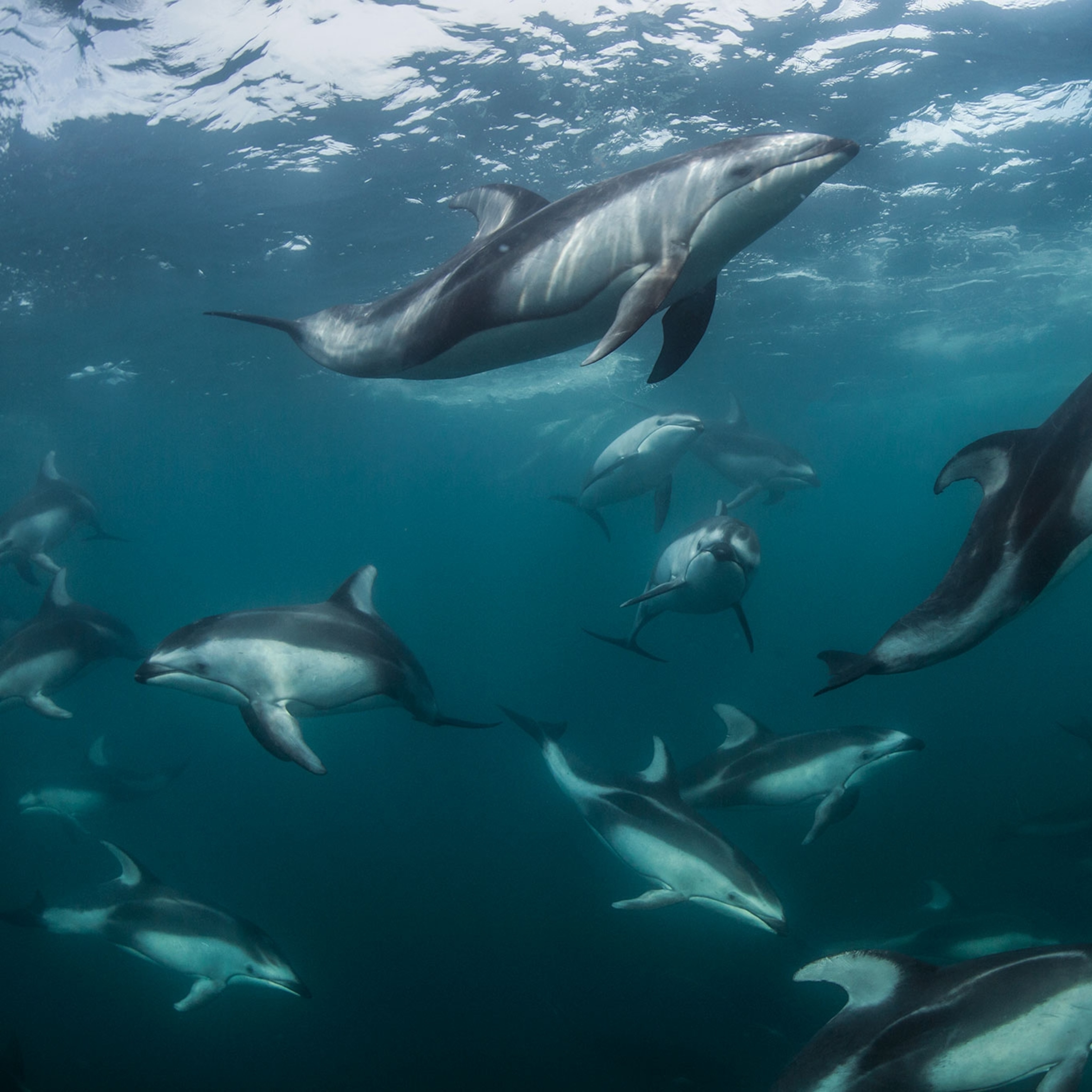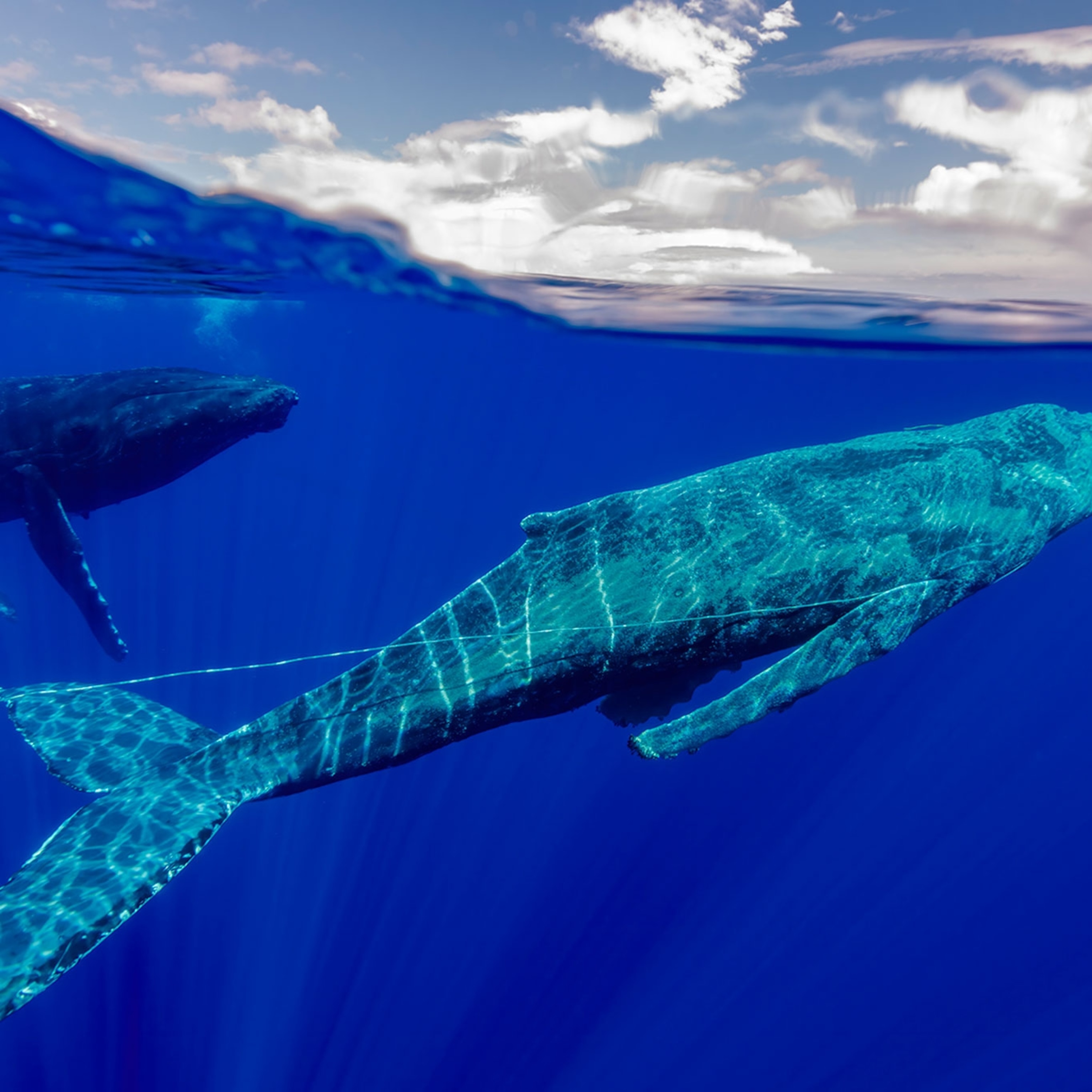
New Diseases, Toxins Harming Marine Life
Dolphins, other marine mammals weakened by pollution, scientists say.
Part of our weekly "In Focus" series—stepping back, looking closer.
The dead sea otters arrived at Melissa Miller's Santa Cruz, California, lab with bright-yellow eyes and gums, their livers destroyed.
One by one, Miller, a marine-wildlife veterinarian, eliminated the potential causes of death until "the last thing I was left with seemed so implausible that I thought I was going crazy."
The otters had been poisoned by a "nasty toxin" called microcystin, which is produced by cyanobacteria, or blue-green algae. Such toxins can appear when human sewage and fertilizers run into lakes and rivers, adding nutrients that spur the growth of algae "superblooms," Miller said.
But sea otters stick to the ocean, never entering the polluted lakes and rivers where these blooms occur.
"I said, OK, we have to figure out how the otters are getting into this," said Miller, of the California Department of Fish and Wildlife and the University of California, Davis.
Miller's sleuthing led her to California's Pinto Lake (map), a water body about 2.5 miles (4 kilometers) from the ocean and so prone to superblooms that Miller said "it'll blow your mind—it looks like fluorescent green paint."
Sure enough, she found that Pinto Lake eventually drains into the Pacific Ocean—close to where the dead otters were found in 2007.
Later experiments revealed the algae's toxins can live for long periods of time in shellfish—otters' main diet. Toxins from the polluted lake were traveling downstream into the ocean, Miller concluded, where they were getting into shellfish and killing otters. (See pictures of threatened marine species.)
Of course, the toll that some types of water pollution take on marine mammals has long been documented. For example, cancer-causing chemicals called PCBs and pesticides like DDT are known to accumulate in marine mammals' fatty tissues and cause serious harm.
But scientists are just now beginning to understand how these and other toxins in the water are spurring the resurgence of some diseases and the creation of others, largely by weakening animals' immune systems. And with more development and pollution in coastal areas, the problem appears to be accelerating.
"Currently there is a general belief that infectious diseases stop where the land and the water meet," said Stephanie Venn-Watson, a veterinarian and director of the One Health Medicine and Research Program, which is part of the National Marine Mammal Foundation (NMMF).
But recent research is showing that such diseases don't discriminate—and the ocean provides "lots of opportunities" for viruses and bacteria to blossom, Venn-Watson said.
Even more worrisome, experts say, is that these organisms could eventually make their way back to land—and to us.
Because people eat shellfish harvested where the land meets the sea, the sea otters may be serving as an "early warning system" for human health risks, Miller said.
Diseased Dolphins
Along Florida's Indian River Lagoon (map) one day last spring, the water looked smooth and clean, the mangroves lush.
But Gregory Bossart knows otherwise.
Since 2003, the Georgia Aquarium's chief veterinarian has been monitoring the health of more than 280 bottlenose dolphins that live along this 170-mile (275-kilometer) stretch of eastern Florida near Fort Pierce, about halfway between Orlando and Fort Lauderdale.
A large team helps him collect a suite of samples from the dolphins, which are catalogued by their dorsal fins.
The prognosis is worrisome: Many of the studied dolphins are sick, suffering from newly described and resurgent diseases that could be triggered by human activities—especially pollution.
Though the process isn't fully understood, pollution and other environmental stressors may be changing the environment here in a way that's favorable for the growth of such diseases, many of which are opportunistic.
As a heavily used recreation area, the Indian River Lagoon has extremely high levels of mercury, mostly due to vehicle exhaust from boats and cars. Coal-fired power plants as far away as China also contribute to mercury pollution in the state.
This toxic metal has been found in dolphins at 20 times the level permitted in human food by the U.S. government.
That exposure could be linked to new papilloma and herpes viruses that have appeared in Indian River dolphins in the last 30 years. The viruses manifest as grisly tumors, sometimes on the dolphins' genitals.
During some recent years, another rare fungal disease called lobomycosis—found only in people and dolphins—has arisen in "epidemic proportions" among Indian River dolphins, Bossart said.
While it's unknown what caused lobomycosis, the diseased animals share a "profoundly" suppressed immune system, he said, likely caused by the dolphins' constant exposure to environmental stressors like mercury. (Also see "Dolphin-Baby Die-Off in Gulf Puzzles Scientists.")
Toxic Wake-up Call
Just up the coast, in southern Georgia, marine scientist Lori Schwacke and colleagues have made similar findings in a population of bottlenose dolphins.
Schwacke, of the U.S. National Oceanic and Atmospheric Administration, has found "extreme" concentrations of chemicals in dolphins living in a coastal area highly contaminated by pollution from a former plastics facility.
Called PCBs, these compounds are byproduct of some industrial and commercial processes that can linger in the environment for decades. (Read more about marine pollution.)
In one recent study of the coastal dolphin population, Schwacke and colleagues found that 26 percent of sampled dolphins in the research area had anemia and decreased immunity.
"The severity of the effects suggests that the PCB mixture to which the Georgia dolphins were exposed has substantial toxic potential," according to a 2011 study led by Schwacke and published in the journal Proceedings of the Royal Society B.
According to the NMMF's Venn-Watson, the marine mammal community has already invested millions of dollars in tracking the emergence of new marine mammal diseases, especially viruses, but "now the challenge is becoming which ones we should care about."
For instance, scientists need to know which viruses are most often fatal, so that they're able to vaccinate a population of animals before the virus spreads.
A measles-like morbillivirus broke out in bottlenose dolphins in the eastern U.S. in the 1980s, likely wiping out half that population, she said. If a similar virus hit the last population of endangered Hawaiian monk seals, it could be the death knell for the entire species.
"Death by a Million Cuts"
As for California's otters, the situation is looking bleak. Miller, the wildlife vet, has been tracking another deadly otter affliction—Toxoplasma, a common parasite that causes a disease called toxoplasmosis and is usually spread by domestic cats. Toxoplasma eggs are shed in the feces of infected animals.
Due in part to exposure to cat feces, toxoplasmosis infects between a third and a half of the world's human population, according to the University of Chicago Medicine's Toxoplasmosis Center.
The parasite is usually dormant, but it can cause health problems if an infected person develops a weak immune system. (Related: "How a Cat-Borne Parasite Infects Humans.")
Miller first observed Toxoplasma in the brain tissue of a dead otter about 14 years ago. After examining hundreds more specimens, Miller realized that otters living near river mouths were almost three times as likely to be infected compared with otters living in areas with low exposure to polluted freshwater runoff.
How did a parasite found in house cats get into the Pacific?
Mainly, because of us. Wherever there are people, there's pavement. And the more smooth surfaces there are, the easier it is for rainwater containing Toxoplasma-ridden cat feces—from lawns, parks, backyards, and more—to be carried downstream with water pollution into rivers and streams, and then into oceans.
Coastal wetlands—which Miller calls "environmental kidneys"—would naturally capture some of the parasite-laden water. But widespread development has destroyed much of California's wetlands, she noted.
Once the Toxoplasma eggs end up in the ocean, they can infect shellfish—such as clams and mussels—for at least three weeks before being eaten by otters.
"These parasites ... have come up with good strategies to survive and propagate themselves," California's Miller said. "The only way you can kill the egg is with fire."
Miller now estimates that 60 to 70 percent of California male otters—the most vulnerable population due to their wandering ways—carry the parasite. Between toxoplasmosis, toxic algae, and other parasites such as sarcocystis, she said, "it's kind of like death by a million cuts."
Likewise, the Georgia Aquarium's Bossart recently discovered that endangered Antillean manatees in Puerto Rico carry Toxoplasma—the first evidence of the parasite in any sirenian, the animal group that includes manatees and dugongs.
It's unknown how the parasite—which has already killed four manatees in Puerto Rico—is getting into the water, but one possibility is that feral-cat feces is ending up in the ocean, said Bossart, who recently published the research in the journal Diseases of Aquatic Organisms.
"Part of what the otters are trying to tell us," Miller said, is that people need to pay more attention to the health of our coasts, which are usually neglected in both research and regulation.
What Goes Around Comes Around
There's another benefit to limiting coastal pollution, Miller added—many of the diseases gaining a foothold in the ocean could eventually affect people, too. (Get the facts on human diseases.)
For instance, a virus could mutate in a marine mammal, jump back to people, and mutate again into a more powerful or deadly strain. This hasn't happened yet, but there have been close calls.
In 2011, a highly pathogenic avian influenza virus infected harbor seals in New England. The flu virus, which was linked to an unusual spate of seal deaths, mutated into another virus that infected mammals even more efficiently—raising concerns that it could jump to people, Venn-Watson said.
And three-fourths of all emerging infectious diseases of humans are zoonotic—meaning the diseases originate in animals-and their incidence is increasing, according to USAID. (See pictures of infectious animals.)
"Each time these changes occur, it provides fodder for pandemics in humans," Venn-Watson said.
Likewise, many of the places where these diseased marine mammals live are sources of seafood. For instance, people regularly eat fish from the PCB-laden waters sickening the Georgia dolphins, Schwacke noted in her study. (Learn about how to get healthy seafood.)
Bossart's project to examine Florida's dolphins has turned into "using dolphins as sentinels for ocean health and human health," he said.
"Ultimately," he added, "it's in our own best interest to investigate all wildlife-health patterns that could potentially affect our own well-being."








